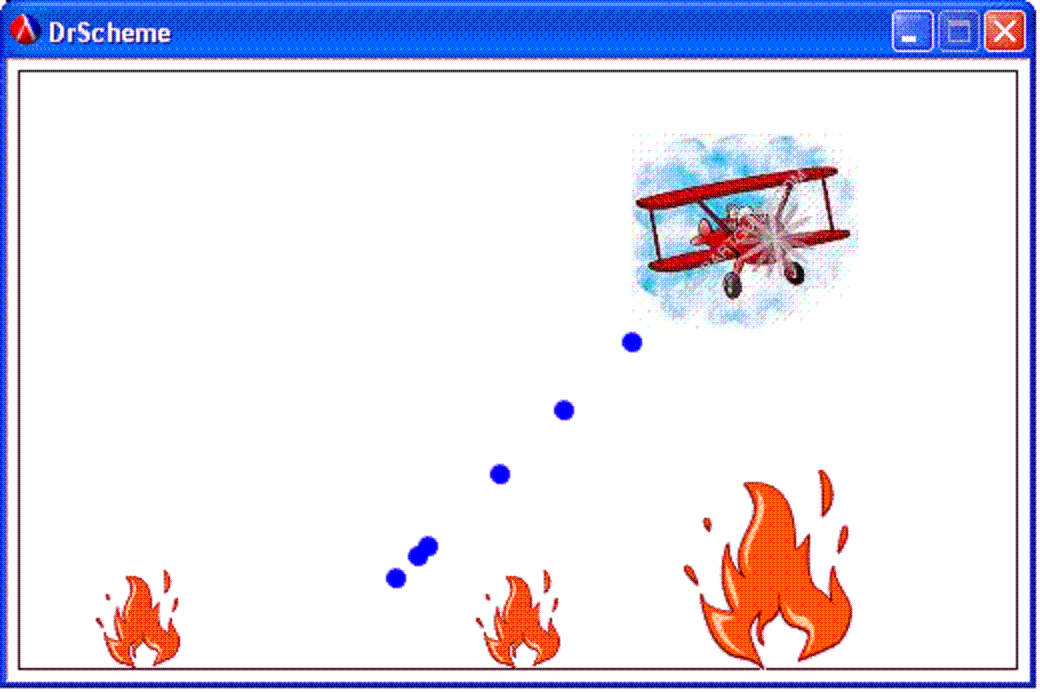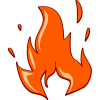CS 1102 (A08) Homework 2: the FireFighter game
Due: September 11 (Thursday) at 11:59pm via turnin (assignment
name hwk2).
Assignment Goals
- To make sure you can write programs using combinations of lists
and structures.
- To practice using the design recipe to organize a nontrivial
program.
The Assignment
Remember to follow the Expectations on
Homework when preparing your solutions, including the academic honesty policy.
|
Your job is to write a simple interactive game in which the player
drops water from a plane onto fires on the ground; the goal of the
game is to put out all of the fires by dropping enough water on them.
A sample appears to the right.
The plane flies continuously back and forth across the screen (ie,
the user does not control whether the plane moves). The player can
change the direction of the plane by pressing the left and right arrow
keys. The player can also drop water from the plane by pressing the
down arrow key. Each fire has an intensity: when a drop of water hits
a fire, the intensity decreases. If a fire burns without water
hitting it, its intensity increases. A fire is extinguished when its
intensity reaches zero.
You will build this game using the same world.ss teachpack used
in lab 1. If you need more documentation than was in lab 1, look up
world.ss in the DrScheme helpdesk.
Work in the "Beginner with List Abbreviations" language level.
| |  |
To write this game, you will need to provide at least the
following:
A data definition for the "world", which is a single data
structure containing all of the information that makes up the current
configuration of the game (such as the plane, fires, and water drops
and their constituent information). Include all data definitions
needed to write your overall world data definition. Do not assume the
same number of fires for every use of the game.
A function draw-world that consumes a world datum
(from the previous item) and produces an image of that world (using
place-image and empty-scene as you did in
lab). The place-image function produces a scene, so you
can nest calls to place-image to put multiple objects
into a single scene.
A function process-keys that consumes a world
datum and a key-event (symbol) and produces a new world datum reflecting
changes in the world based on keys pressed.
A function update-world that consumes a world and
produces a world reflecting what happens when no key is pressed (ie,
the plane continues to move, the water continues to fall, etc).
Once you have these functions, you will run your game using the
commands (as you did in lab):
(big-bang WIDTH HEIGHT (/ 1.0 28) INITWORLD)
(on-redraw draw-world)
(on-key-event process-keys)
(on-tick-event update-world)
where WIDTH, HEIGHT, and INITWORLD are constants you define for the
size of the game window and the initial configuration of the game.
You must decide what other functions to implement as part of
writing the required functions listed above. However, we expect
you to follow the design-recipe strategy presented in class in which
one function processes one data definition (as we saw in list of
structs). You may bend this rule for posns located directly within
other structures (ie, you don't need a separate function just to
process the posn), but not otherwise. If you don't follow the design
recipe, this assignment will take you FAR longer than necessary.
You'll also lose substantial points.
Strategy
If you and your partner prefer to work separately, work out and
agree on the data definition first, then proceed to work on the rest
of the code (together or independently).
Implement the game in stages, not all at once. Start with a
simple version that lets the user change the direction of the plane's
movement, but has no fires or water. Once you have that working, add
the water drops and get them to fall. Once that is working, add the
fires. Get the fires to decrease in intensity when water hits them,
then get them to increase in intensity when no water falls on
them. You will get more credit for a fully-working solution to part
of the game than for a non-working solution to the whole game.
You should have the game working at least through water drops falling
for a passing grade on this assignment.
Hints and FAQs
You will be graded primarily on the structure of your code, not
on efficiency. Don't worry about efficiency. Your computations to
check whether a water drop has hit a fire need to be reasonable, but
do not need to be exact (ie, don't waste time on getting these
expressions correct down to the pixel). If the
resulting game play looks plausible, we won't care about the precise
formula you used.
You may simply specify a stop-when? function to
stop the game when all fires are extinguished. You do not need to add
fancy screen graphics with the result of the game; you will NOT get
extra points for doing so (though you are welcome to do this if you
want).
You may use whatever images you wish for the pieces of the game
(the ones we used are below; feel free to use them or plain circles
and rectangles if you prefer). We used the built-in (in world.ss)
circle operator to draw the water drops and the different
sized fire images for different ranges of intensity of fires. You do
not need to reverse the image of the plane when it reverses direction
or do anything fancy with the graphics. NO extra points for fancy
graphics work.
You need test cases for functions that return data, but not for
functions that produce images or scenes.
Remove extinguished fires from the world: certain aspects of
the game will be much easier to program if you do this.
Raise the intensity of the fire at a much lower rate than you
drop it (or the game becomes unplayable). Our prototype raised
intensity at 1/100 the rate of lowering it, for example. Use real
numbers rather than integers for this.
Our Images
Use the "insert image" option under the "special" menu to load an
image into your DrScheme file; you can use define to give an image a
name. We used the circle operator (defined in world.ss)
to get images for the water drops.




Icons are from school-clip-art.com
(fire) and clipartguide.com (plane).
What to Turn In
Turn in a single file hwk2.ss or hwk2.scm containing
all code and documentation for this assignment. Make sure that both
students' names are in a comment at the top of the file.
Back to the Assignments page



